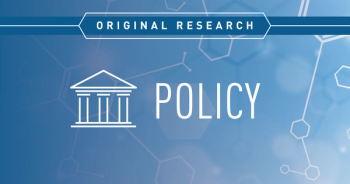
The American Journal of Managed Care
- October 2018
- Volume 24
- Issue 10
Nudging Physicians and Patients With Autopend Clinical Decision Support to Improve Diabetes Management
Incorporating an autopend functionality into clinical decision support improved glycated hemoglobin laboratory test completion by between 21.1% and 33.9% for reminder messages read within 57 days.
ABSTRACT
Objectives: To determine the impact on routine glycated hemoglobin (A1C) laboratory test completion of incorporating an autopend laboratory order functionality into clinical decision support, which (1) routed provider alerts to a separate electronic folder, (2) automatically populated preauthorization forms, and (3) linked the timing and content of electronic patient health maintenance topic (HMT) reminders to the provider authorization.
Study Design: Observational pre-post study from November 2011 (1 year before autopend) through June 2014 (1.5 years after).
Methods: The study included HMT reminders concerning an A1C test for patients with type 1 or type 2 diabetes (N = 15,630 HMT reminders; 8792 patients) in a large multispecialty ambulatory healthcare system. A Cox proportional hazard model, adjusted for patient and provider demographics, estimated the likelihood of laboratory test completion based on 3 HMT reminder characteristics: preautopend versus postautopend period, read versus unread, and the patient’s time to reading.
Results: In the postautopend period, the median time for patients to read reminders decreased (1 vs 3 days; P <.001) and the median time to complete laboratory tests decreased (40 vs 48 days; P <.001). Comparing preautopend HMT reminders with a similar time to reading, the likelihood of A1C laboratory test completion increased after autopend by between 21.1% (hazard ratio [HR], 1.211; P = .050), when time to reading was 57 days, and 33.9% (HR, 1.339; P = .003), when time to reading was 0 days. This result included 68% of the reminders. There was no statistical difference in A1C laboratory test completion for unread reminders in the preautopend versus postautopend period.
Conclusions: Automated patient-centered decision support can improve guideline-concordant monitoring of A1C among patients with diabetes, particularly among patients who read reminders in a timely fashion.
Am J Manag Care. 2018;24(10):479-483Takeaway Points
- Incorporating an autopend functionality into clinical decision support coordinates and streamlines the process of completing routine preventive diabetes care.
- Autopend routed provider alerts to a separate electronic folder for batch completion, automatically populated preauthorization forms, and linked the timing and content of the patient reminder messages to the authorization.
- Among patient reminder messages read within 57 days, the likelihood of glycated hemoglobin laboratory test completion increased by between 21.1% (P = .050) and 33.9% (P = .003) after autopend. This result included 68% of the reminders.
- Autopend can improve guideline-concordant monitoring of chronically ill patients in the spirit of the Quadruple Aim.
The timely completion of routine preventive care is critical for diabetes management, yet only 39.5% of US patients diagnosed with diabetes have received all guideline-recommended services.1,2 Stage II of the Meaningful Use legislation, Medicare’s Electronic Health Record (EHR) Incentive Program, requires the use of clinical decision support (CDS) to remind patients about preventive care. However, Medicare states that there is no definitive or comprehensive list of what constitutes CDS, partly to encourage the creation of novel and innovative CDS tools.3
Various CDS systems have been developed to improve the completion of routine preventive diabetes care. The use of electronic reminders to providers, often in the patient’s chart, prompts limited improvement,4-6 partly because providers respond 30% to 40% of the time.7,8 Study results have shown that electronic reminders sent directly to patients improve diabetes management.9,10 However, a randomized controlled trial involving electronic alerts to both patients and providers had mixed findings.11 This suggests that the interaction between patient and clinician interventions within CDS may be critical, especially if these systems developed independently.
The provider—patient interface can inadvertently generate barriers to preventive care. Providers are required to review and authorize each laboratory order, even if they occur routinely. Providers and patients may fail to perform required tasks (eg, authorization or laboratory test completion) without prompting.12 However, locating provider alerts in the patient’s chart contributes to alert fatigue and creates challenges for patient management between visits.8 When patient alerts are triggered independently of the clinician authorization, patients may need to complete additional burdensome steps to confirm the laboratory order’s authorization, such as checking with the provider’s office, the laboratory, or additional websites.
Health information technology leaders at Sutter Health, a large nonprofit integrated healthcare delivery system headquartered in Sacramento, California, designed and incorporated an autopend functionality into the CDS. Autopend aimed to nudge providers and patients by simplifying workflow, removing barriers, and coordinating actions to improve preventive care. We examined whether incorporating an autopend functionality improved the likelihood of routine glycated hemoglobin (A1C) laboratory test completion for patients with diabetes.
RESEARCH DESIGN AND METHODS
Study Setting
The study was conducted at the Palo Alto Medical Foundation (PAMF), an affiliate of Sutter Health. PAMF is an ambulatory healthcare system serving more than 1 million patients in northern California. It has used a fully integrated EpicCare EHR with electronic health maintenance topic (HMT) patient reminders since 1999. The autopend functionality was activated on November 13, 2012.
Study Design
We conducted an observational pre-post study at the HMT reminder level and tracked associated A1C laboratory test completion. We compared HMT reminders sent in the year before autopend (November 1, 2011-November 13, 2012) with those in the 1.5 years after (November 13, 2012-June 30, 2014). Our data recorded laboratory test completion for an additional 6 months (through December 2014). We included all HMT reminders sent to patients eligible for autopend, who were defined as those with a problem list diagnosis of diabetes mellitus (International Classification of Diseases, Ninth Revision codes 250.xx, 401.xx, 790.xx, 272.xx, 791.xx, 790.29), a designated primary care provider (PCP), and an activated patient portal (MyHealthOnline). A total of 8792 patients received 15,630 HMT reminders.
Autopend Functionality and the HMT System
Preautopend. HMT reminders were sent to patients independently of providers’ authorization. All HMT reminders included “usual” content, which stated “you are due for” an A1C test and instructed patients to check a website to see if their laboratory tests had been ordered. If not, patients had to contact their provider. The CDS included provider alerts only in the patient’s chart. Providers learned about upcoming laboratory tests either when contacted by a patient or if they opened the patient’s chart, perhaps during an office visit. The provider then reviewed the order, filled out the authorization form, and contacted the patient.
Postautopend. Autopend (1) routed upcoming laboratory test notifications to a separate electronic folder, in addition to including an alert in the patient’s chart; (2) automatically populated or “pended” preauthorization forms in the electronic folder; and (3) linked the timing and content of the patient HMT reminders to the provider authorization. If the provider approved the order, an HMT reminder with autopend content was sent to patients stating “your clinician has ordered” an A1C test and they could proceed directly to the laboratory. In this case, the patient could skip checking the website and potentially following up with their provider. If the provider declined or ignored the notification, an HMT reminder with usual content was sent and patients had to complete the additional steps (eAppendices A, B, and C [
Data
EHR data were combined with HMT metadata. We used a structured text mining process to categorize patient HMT reminders according to autopend and usual content.
Measures
Patient HMT reminders. “Post autopend” indicated all HMT reminders sent after November 13, 2012. “Read reminder” recorded whether the patient clicked on the HMT reminder. “Time to reading” measured the number of days between when the HMT reminder was sent and when the patient clicked on it.
Time to laboratory test completion. This measured the number of days between when the HMT reminder was sent and laboratory test completion.
Statistical Analysis
We examined unadjusted differences in patient, provider, and HMT reminder characteristics for reminders sent in the preautopend and postautopend periods. P values were calculated based on the results of χ2 tests, t tests, and nonparametric equality of medians tests.
A Cox proportional hazard model13 was used to estimate the likelihood of laboratory test completion based on 3 HMT reminder characteristics: preautopend versus postautopend period, read versus unread, and time to reading. The model adjusted for patient’s sex, self-reported race/ethnicity, age, insurance type, and Charlson Comorbidity Index score,14 along with the sex and specialty of the patient’s PCP. We addressed missing data in the explanatory variables by including a category for unknown. To account for repeated HMT reminders within patients, we clustered standard errors at the patient level. We included quarter fixed effects to control for secular trends. Schoenfeld tests rejected the proportional hazards assumption, so we added time-varying covariates with a natural log of time specification.13 We used the STCOX and LINCOM procedures in Stata 13.1 (StataCorp LP; College Station, Texas) and reported estimates in hazard ratios (HRs).15
RESULTS
In the period before autopend, 6329 HMT reminders were sent to 5197 patients (
In the preautopend period, all HMT reminders had usual content. Most reminders (85.2%) were read by the end of the study period (Table 1). However, the median time to reading was 3 days, and 75% of the reminders were read within 38 days. Most of the laboratory tests associated with the reminders (81.2%) were completed by the end of the study period. The median time to completion was 48 days, with 75% of the laboratory tests completed within 106 days.
In the postautopend period, 87.0% of the HMT reminders included autopend content, reflecting the proportion of autopended orders approved by the PCPs, whereas 13.0% included usual content, which resulted from rejected orders. HMT reminders in the postautopend period were read slightly sooner than those in the preautopend period (median time to reading, 1 day vs 3 days; P <.001) (Table 1). eAppendix D illustrates that in the first 2 months after a reminder was sent, reminders with either autopend or usual content sent in the postautopend period were slightly more likely to be read than reminders sent in the preautopend period. The median time to laboratory test completion was also 8 days shorter in the post­autopend period (40 days vs 48 days; P <.001) (Table 1; eAppendix E). eAppendix D illustrates that 2 months after the reminder was sent, read reminders with autopend content were associated with higher rates of laboratory test completion (59.5%) than read reminders with usual content in either the preautopend period (52.2%) or the postautopend period (42.2%; P <.001).
Next, we compared the adjusted effect of receiving an HMT reminder in the postautopend period for read and unread reminders (
We also compared the adjusted effect of reading an HMT reminder in the preautopend and postautopend periods (Table 2). In the preautopend period, a read reminder was associated with a 76.7% increase in the likelihood of laboratory test completion (HR, 1.767; P <.001; time to reading, 0 days) compared with an unread reminder. However, in the postautopend period, a similar read reminder was associated with a 143.1% increase in likelihood of completion (HR, 2.431; P <.001; time to reading, 0 days).
DISCUSSION
We evaluated the impact of incorporating a novel autopend functionality into the CDS on routine A1C laboratory test completion. We found that for HMT reminders read within 57 days, reminders sent in the postautopend period were associated with a 21.1% (HR, 1.211; P = .050) to 33.9% (HR, 1.339; P = .003) increase in the likelihood of laboratory test completion. This result included 68% of the HMT reminders. However, the likelihood of laboratory test completion decreased the longer it took the patient to read the reminder. Among unread reminders, we found no statistical difference in A1C laboratory test completion in the postautopend period.
The autopend design was guided by the behavioral economics principle of nudging people to do the right thing. Autopend allowed the majority of patients to skip checking an additional website and potentially contacting their provider to check the laboratory test’s authorization status. Relocating provider triggers from the patient’s chart to a separate electronic folder for providers to approve, as well as coordinating the timing and content of the patient reminders with the provider authorization, may have minimized alert fatigue,16 the electronic task demand (eg, clicks, data entry, and time), and the downstream actions required by both parties. This in turn may have reduced providers’ workflow interruption and cognitive burden, improving job performance and satisfaction.17,18 However, the effects of these design features were associated with diminishing improvements for patients who took longer to read their reminders.
Although 87.0% of the postautopend period HMT reminders had autopend content, caution should be exercised before concluding that laboratory test completion rates could have been higher had all patients received autopend content. Patient and provider characteristics associated with the usual-content HMT reminders, and not the actual reminder content, may have contributed to the lower rates. Future research should explore these factors and the CDS designs that address them.
Stage II of the Meaningful Use criteria established expectations of using CDS to engage patients and improve population health.19 Although technology such as autopend may have an important role in helping health systems realize the potential of EHRs, physicians spend significant time meeting the demands of “desktop medicine.”20-22 Requiring physicians to approve autopend orders for regulatory compliance, rather than allowing them to go directly to patients or to the inboxes of other care team members, may have unintended consequences on physicians’ workflow. The functionality may need to be modified to enable other care team members to approve these orders.
Limitations
This study has some limitations. The observational pre-post study design limits our ability to rule out confounding factors. However, we did statistically control for time trends through the use of quarter fixed effects. Secondly, this study took place in a single multispecialty delivery organization, which was an early adopter of EHRs, and autopend was added onto an existing EpicCare-specific HMT reminder system. Furthermore, this study included only patients with an active patient portal, limiting generalizability to other settings and patient populations. However, these principles of CDS design could be applied to other EHR systems.
CONCLUSIONS
Our study results suggest that incorporating an autopend functionality into a CDS system was associated with improvements in A1C laboratory test completion among patients with diabetes who read their HMT reminders in a timely fashion. This multifaceted functionality was designed to simplify workflow, remove barriers, and coordinate the actions of patients and clinicians. Such a CDS tool can improve the care of chronically ill patients in the spirit of the Quadruple Aim.23Author Affiliations: Hutchinson Institute for Cancer Outcomes Research, Fred Hutchinson Cancer Research Center (LP), Seattle, WA; Sutter Health Office of Patient Experience (AC), Sacramento, CA; Palo Alto Medical Foundation Research Institute (AC, YY, CO), Palo Alto, CA; University of California San Diego School of Medicine (MT-S), San Diego, CA.
Source of Funding: Agency for Healthcare Research and Quality R18 HS 019167.
Author Disclosures: The authors report no relationship or financial interest with any entity that would pose a conflict of interest with the subject matter of this article.
Authorship Information: Concept and design (LP, AC, YY, CO, MT-S); acquisition of data (CO, MT-S); analysis and interpretation of data (LP, AC, YY, CO); drafting of the manuscript (LP, AC); critical revision of the manuscript for important intellectual content (LP, AC, YY, MT-S); statistical analysis (YY); provision of patients or study materials (MT-S); obtaining funding (MT-S); administrative, technical, or logistic support (AC); and supervision (MT-S).
Address Correspondence to: Laura Panattoni, PhD, Hutchinson Institute for Cancer Outcomes Research, Fred Hutchinson Cancer Research Center, 1100 Fairview Ave N, Seattle, WA 98109. Email: lpanatto@fredhutch.org.REFERENCES
1. Hsu WC. Consequences of delaying progression to optimal therapy in patients with type 2 diabetes not achieving glycemic goals. South Med J. 2009;102(1):67-76. doi: 10.1097/SMJ.0b013e318182d8a2.
2. CDC. Prevalence of receiving multiple preventive-care services among adults with diabetes — United States, 2002-2004. CDC website. cdc.gov/mmwr/preview/mmwrhtml/mm5444a5.htm. Published November 11, 2005. Accessed September 14, 2017.
3. eHealthUniversity. Clinical decision support: more than just ‘alerts’ tipsheet. CMS website. cms.gov/regulations-and-guidance/legislation/EHRincentiveprograms/downloads/clinicaldecisionsupport_tipsheet-.pdf. Published 2014. Accessed September 14, 2017.
4. Tierney WM, Hui SL, McDonald CJ. Delayed feedback of physician performance versus immediate reminders to perform preventive care: effects on physician compliance. Med Care. 1986;24(8):659-666.
5. Garg AX, Adhikari NKJ, McDonald H, et al. Effects of computerized clinical decision support systems on practitioner performance and patient outcomes: a systematic review. JAMA. 2005;293(10):1223-1238. doi: 10.1001/jama.293.10.1223.
6. Shojania KG, Jennings A, Mayhew A, Ramsay CR, Eccles MP, Grimshaw J. The effects of on-screen, point of care computer reminders on processes and outcomes of care. Cochrane Database Syst Rev. 2009;(3):CD001096. doi: 10.1002/14651858.CD001096.pub2.
7. Embi PJ, Leonard AC. Evaluating alert fatigue over time to EHR-based clinical trial alerts: findings from a randomized controlled study. J Am Med Inform Assoc. 2012;19(e1):e145-e148. doi: 10.1136/amiajnl-2011-000743.
8. Ash JS, Sittig DF, Campbell EM, Guappone KP, Dykstra RH. Some unintended consequences of clinical decision support systems. AMIA Annu Symp Proc. 2007:26-30.
9. Halbert RJ, Leung KM, Nichol JM, Legorreta AP. Effect of multiple patient reminders in improving diabetic retinopathy screening. a randomized trial. Diabetes Care. 1999;22(5):752-755. doi: 10.2337/diacare.22.5.752.
10. Tricco AC, Ivers NM, Grimshaw JM, et al. Effectiveness of quality improvement strategies on the management of diabetes: a systematic review and meta-analysis. Lancet. 2012;379(9833):2252-2261. doi: 10.1016/S0140-6736(12)60480-2.
11. Wright A, Poon EG, Wald J, et al. Randomized controlled trial of health maintenance reminders provided directly to patients through an electronic PHR. J Gen Intern Med. 2012;27(1):85-92. doi: 10.1007/s11606-011-1859-6.
12. Ziemer DC, Doyle JP, Barnes CS, et al. An intervention to overcome clinical inertia and improve diabetes mellitus control in a primary care setting: Improving Primary Care of African Americans with Diabetes (IPCAAD) 8. Arch Inter Med. 2006;166(5):507-513. doi: 10.1001/archinte.166.5.507.
13. Schoenfeld D. Partial residuals for the proportional hazards regression model. Biometrika. 1982;69(1):239-241. doi: 10.2307/2335876.
14. Charlson ME, Pompei P, Ales KL, MacKenzie CR. A new method of classifying prognostic comorbidity in longitudinal studies: development and validation. J Chronic Dis. 1987;40(5):373-383.
15. STATA Survival Analysis and Epidemiological Tables Reference Manual Release 13. College Station, TX: Stata Press; 2013.
16. Kesselheim AS, Cresswell K, Phansalkar S, Bates DW, Sheikh A. Clinical decision support systems could be modified to reduce ‘alert fatigue’ while still minimizing the risk of litigation. Health Aff (Millwood). 2011;30(12):2310-2317. doi: 10.1377/hlthaff.2010.1111.
17. Baethge A, Rigotti T. Interruptions to workflow: their relationship with irritation and satisfaction with performance, and the mediating roles of time pressure and mental demands. Work Stress. 2013;27(1):43-63. doi: 10.1080/02678373.2013.761783.
18. Weigl M, Müller A, Vincent C, Angerer P, Sevdalis N. The association of workflow interruptionsand hospital doctors’ workload: a prospective observational study. BMJ Qual Saf. 2012;21(5):399-407. doi: 10.1136/bmjqs-2011-000188.
19. Meaningful Use and MACRA. HealthIT.gov website. healthit.gov/topic/meaningful-use-and-macra/meaningful-use-and-macra. Accessed February 8, 2017.
20. Sinsky C, Colligan L, Li L, et al. Allocation of physician time in ambulatory practice: a time and motion study in 4 specialties. Ann Intern Med. 2016;165(11):753-760. doi: 10.7326/M16-0961.
21. Shanafelt T, Dyrbye L, Sinsky C, et al. Relationship between clerical burden and characteristics of the electronic environment with physician burnout and professional satisfaction. Mayo Clin Proc. 2016;91(7):836-848. doi: 10.1016/j.mayocp.2016.05.007.
22. Tai-Seale M, Olson CW, Li J, et al. Electronic health record logs indicate that physicians split time evenly between seeing patients and desktop medicine. Health Aff (Millwood). 2017;36(4):655-662. doi: 10.1377/hlthaff.2016.0811.
23. Bodenheimer T, Sinsky C. From Triple to Quadruple Aim: care of the patient requires care of the provider. Ann Fam Med. 2014;12(6):573-576. doi: 10.1370/afm.1713.
Articles in this issue
about 7 years ago
From the Editorial Board, October 2018: Bruce W. Sherman, MDover 7 years ago
Recent Study on Site of Care Has Severe Limitationsover 7 years ago
The Authors Respond and Stand Behind Their Findingsover 7 years ago
CMS HCC Risk Scores and Home Health Patient Experience MeasuresNewsletter
Stay ahead of policy, cost, and value—subscribe to AJMC for expert insights at the intersection of clinical care and health economics.







































